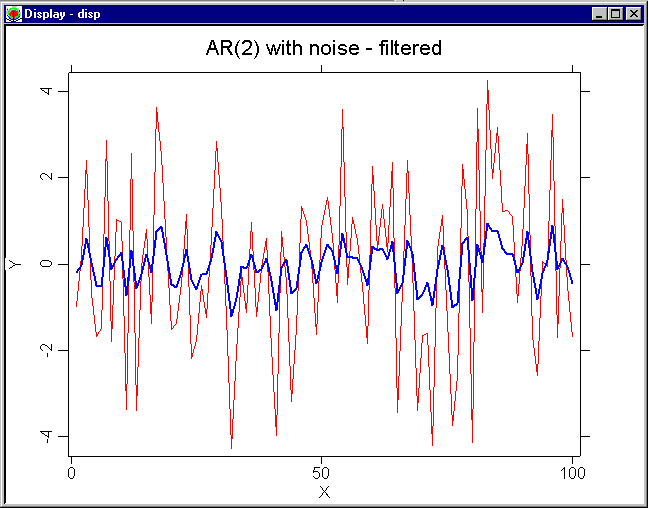The state-space model consists of two processes -- an observation process
![]() and an unobservable state process
and an unobservable state process
![]() .
Having a sampling of observations made up to time
.
Having a sampling of observations made up to time ![]() , denoted as
, denoted as
![]() , we want to find the best estimate of the state
, we want to find the best estimate of the state
![]() that we denote as
that we denote as
![]() . The particular error covariance
matrix is then denoted
. The particular error covariance
matrix is then denoted
![]() .
Three different problems are recognized due to different relations between
.
Three different problems are recognized due to different relations between
![]() and
and ![]() :
:
To determine the best estimate, the Kalman filtering approach uses
the mean squared error (MSE) criterion given as
![]() . According to this criterion the best estimate is the conditional expectation
. According to this criterion the best estimate is the conditional expectation
![]() .
This expectation is generally nonlinear (and usually difficult to find)
and therefore we confine ourselves to linear filters.
Since we assume the orthogonality of
.
This expectation is generally nonlinear (and usually difficult to find)
and therefore we confine ourselves to linear filters.
Since we assume the orthogonality of
![]() we are able to derive
the desired best linear estimate using techniques of projections onto
Hilbert space generated by the observations
we are able to derive
the desired best linear estimate using techniques of projections onto
Hilbert space generated by the observations ![]() .
.
As a result we get the Kalman filter equations
Several remarks should be made about the Kalman filter equations. First the
inversion of ![]() may be replaced with a pseudoinversion. This is
generally the case in models with
may be replaced with a pseudoinversion. This is
generally the case in models with ![]() singular. Next, the Kalman filter
is a minimum square error estimator among all linear
estimators but in the case of a Gaussian model it is the minimum square error
estimator among all estimators and
singular. Next, the Kalman filter
is a minimum square error estimator among all linear
estimators but in the case of a Gaussian model it is the minimum square error
estimator among all estimators and
![]() , i.e. the Kalman filter yields
the whole information about the conditional distribution of
, i.e. the Kalman filter yields
the whole information about the conditional distribution of ![]() (this,
however, does not hold in a general non-Gaussian model where the Kalman
filter yields only information about the first two moments of the conditional
distribution of
(this,
however, does not hold in a general non-Gaussian model where the Kalman
filter yields only information about the first two moments of the conditional
distribution of ![]() ).
).
The Kalman filtration equations are implemented in the quantlet
 kfilter
. The input parameters of this quantlet are the
time series to be filtered (possibly multivariate), and the system matrices
of the underlying state-space model. To filtrate the time series ar2
simulated in the first example type the following instructions.
kfilter
. The input parameters of this quantlet are the
time series to be filtered (possibly multivariate), and the system matrices
of the underlying state-space model. To filtrate the time series ar2
simulated in the first example type the following instructions.
x0 = #(0,0) Sig = #(0,0)~#(0,0) H = 1~0 F = #(0.5,1)~#(-0.3,0) Q = 4 R = #(1,0)~#(0,0) filtered = kfilter(ar2,x0,Sig,H,F,Q,R)
library("plot")
orig = vec(1:T)~ar2
filt = vec(1:T)~filtered
orig = setmask(orig, "line", "red", "thin")
filt = setmask(filt, "line", "blue", "medium")
disp = createdisplay(1,1)
show(disp,1,1, orig, filt)
setgopt(disp,1,1, "title", "AR(2) with noise - filtered")

The quantlet
 kfilter
saves the file KFOutPut.dat
into the
XploRe
working directory. This file contains all filtered
state estimates
kfilter
saves the file KFOutPut.dat
into the
XploRe
working directory. This file contains all filtered
state estimates
![]() and their error covariance matrices
and their error covariance matrices
![]() and might be used to track the development of the estimations'
errors or for prediction purposes.
and might be used to track the development of the estimations'
errors or for prediction purposes.
The matrices
![]() are vectorized and appended to the state
estimation but each of them may be easily recovered. The values of
are vectorized and appended to the state
estimation but each of them may be easily recovered. The values of
![]() and
and
![]() might be recovered in the
following way:
might be recovered in the
following way:
KFOutPut = read("KFOutPut.dat")
dimX = rows(x0)
x50 = (KFOutPut[50,1:dimX])'
P50 = reshape(KFOutPut[50,dimX+1:dimX+dimX^2],#(dimX,dimX))
Kalman smoothing equations are implemented by the quantlet
 ksmoother
.
Its usage is similar to the quantlet
ksmoother
.
Its usage is similar to the quantlet
 kfilter
. Input parameters consist of the
time series to be smoothed (possibly multivariate) and the system matrices of the
underlying state-space model. In the following sample code the time series ar2
is smoothed and the result is visualized.
kfilter
. Input parameters consist of the
time series to be smoothed (possibly multivariate) and the system matrices of the
underlying state-space model. In the following sample code the time series ar2
is smoothed and the result is visualized.
smoothed = ksmoother(ar2,x0,Sig,H,F,Q,R) smoot = vec(1:T)~smoothed smoot = setmask(smoot, "line", "blue", "medium") disp = createdisplay(1,1) show(disp,1,1, orig, smoot) setgopt(disp,1,1, "title", "AR(2) with noise - smoothed")
 ksmoother
uses the file KFOutPut.dat during the
backward recursions. It generates the file KSOutPut and saves it
into the
XploRe
working directory. Again, this file might be used for analytical
purposes.
ksmoother
uses the file KFOutPut.dat during the
backward recursions. It generates the file KSOutPut and saves it
into the
XploRe
working directory. Again, this file might be used for analytical
purposes.